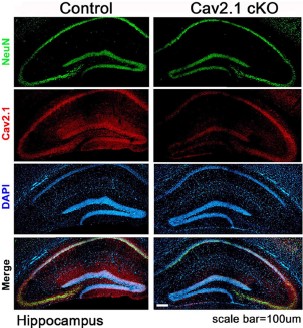Overview
- Peptide (C)PSSPERAPGREGPYGRE, corresponding to amino acid residues 865-881 of rat CACNA1A (Accession P54282). Intracellular loop between domains II and III.
 Western blot analysis of rat brain membranes:1. Anti-CACNA1A (CaV2.1) Antibody (#ACC-001), (1:200).
Western blot analysis of rat brain membranes:1. Anti-CACNA1A (CaV2.1) Antibody (#ACC-001), (1:200).
2. Anti-CACNA1A (CaV2.1) Antibody, preincubated with CACNA1A/Cav2.1 Blocking Peptide (#BLP-CC001).- Rat brain membranes (1:200). Human red blood cells (see Andrews, D.A. et al. (2002) Blood 100, 3392.).
- Mouse cerebellum (1:100).
- Mouse sperm cells (Serrano, C.J. et al. (1999) FEBS Lett. 462, 171.).
Voltage-dependent Ca2+ channels (CaV channels) are pivotal players in many physiological roles such as secretion, contraction, migration and excitation.1
The voltage-dependent calcium channels are composed of several subunits; α1, β, α2δ and γ. CaV channels were originally divided into six physiological types: L-, N-, P-, Q-, R-, and T-type.
The CaV2.1 (formally named α1A) makes up the α1 poreforming subunit in P/Q-type Ca2+ channel family. It is expressed preferentially in the central nervous system where along with CaV2.2 is responsible for pre-synaptic Ca2+ influx and neurotransmitter release.1,2
Mutations in CACNA1A (CaV2.1) have been shown to cause several neurological disorders among them are familial hemiplegic migraine, episodic ataxia type 2, and spinocerebellar ataxia type 6 (SCA6).1,3-5
The involvement of CaV2.1 in synaptic transmission was assessed by using ω-Agatoxin IVA (#STA-500), a specific blocker of the CaV2.1 channel.6 The blocking sensitivity is dependent on the α subunit isoform and on the splice variant.7,8
Application key:
Species reactivity key:

Expression of CaV2.1 in mouse hippocampus.Immunohistochemical staining of mouse hippocampal sections using Anti-CACNA1A (CaV2.1) Antibody (#ACC-001). CaV2.1 staining (red) is largely detected in the CA1 region and co-localizes with NeuN, a neuronal marker. Note the significant decrease in CaV2.1 detection in CaV2.1 conditional knockout mice (right panels).Adapted from Jung, D. et al. (2016) Front. Behav. Neurosci. 10, 214. with permission of Frontiers.
